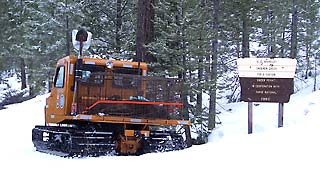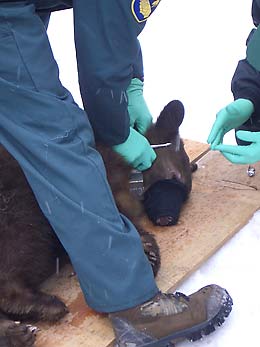UC Berkeley Web Feature
 |
California Department of Fish & Game biologists Doug Updike (front) and Jason Holley prepare one of the yearling black bears to move into its new home at Sagehen Creek Field Station. (Photos by Jeff Brown/UC Berkeley) |
UC Berkeley's Sagehen Creek Field Station is home to two new Cal bears
BERKELEY – Two yearling black bears are snoozing peacefully in their new den beneath 10 inches of fresh snow after being relocated Feb. 18 to the University of California, Berkeley's Sagehen Creek Field Station in the Sierra Nevada.
The 85-pound female black bears were orphaned last June and have been cared for since then at Lake Tahoe Wildlife Care in South Lake Tahoe. Though from different mothers, the cubs quickly bonded and were judged by biologists at the California Department of Fish & Game as good candidates for reintroduction to the wild. According to Fish & Game statewide bear coordinator Doug Updike, fewer than a handful of bears each year in California are suitable for reintroduction, so these two are the lucky ones.
 The two sedated bears, snoozing in their temporary traveling cage, are carried into the Sagehen Creek Field Station on the back of a Sno-Cat. |
"The number one criterion is that they are not imprinted on people, that they don't have any acclimation to humans for food or cover or any aspect of their habitat," said Updike, noting that the bears had been raised out of sight of humans since they were first brought in weighing a mere 20 pounds each. One cub's mother was killed by a car near Fallen Leaf Lake, while the other youngster was picked up alone, presumably orphaned, at Bliss State Park.
"The best candidates are snarly; they don't like people. If you get too close to them, they get aggressive, they clearly hate being around people. Those are perfect candidates for going out, because that is the way a wild bear is supposed to act."
Updike thought of Sagehen as a bear rehabilitation site because he has been following one of the local bears as part of a study, and thus knew the 8,000-acre watershed offered good bear habitat. Some eight to 10 bears make their homes there, he said. Last summer, for the first time, he brought his American River College class to Sagehen for a week to study bears.
Working with station manager Jeff Brown, Updike and his Fish & Game colleagues identified a suitable site for the rehabilitated bears on a north-facing slope near Sagehen Creek, not far from a meadow that can provide fresh green spring forage when the animals wake up in about six weeks.
 Fish & Game biologists attach a temporary radio collar to one of the bears to track it during its first months in the wild. They are wearing latex gloves so as not to leave their scent on the young bear. |
On Thursday, Feb. 17, Brown led a team of Fish & Game biologists on snowmobiles to scout out the den sites and, once they had settled on one, to build a den - a dog igloo donated by PETsMART and buried in the snow. The next day, the sedated bears were shuttled to the field station to be ferried by Sno-Cat to the remote den site. Bear hair samples were taken for a DNA record, their ears were tagged, and temporary GPS tracking devices were strapped around their necks. The sedated bears were then nestled inside the igloo on a bed of pine boughs, including some from their previous home, and the igloo entrance was covered with more pine boughs.
"It was just a big puppy pile," said Brown.
Fish & Game escorted a few journalists to the bear igloo aboard snowmobiles, but Brown emphasized the need to keep the den site secret. "They're in a remote site, and 10 inches of really wet snow over the weekend obscured all signs of our being there," Brown said.
While Fish & Game biologists did all they could to make the bears' den homey, Updike said that the yearlings might just pick up and look for new digs within the next week - hence the radio collars, which he'll use to locate them. In his experience, half of all rehabilitated cubs wake up and find their own denning spot, typically a hollowed-out log or, if Tahoe bears are typical of those in the Northern Sierra, perhaps 40 feet up inside a hollow tree. He thinks the two young bears have a good chance of making it, even though they are the new kids in bear territory.
"These bears will have a chance to be free, wild bears and to deal with the challenges of predation and competition," Updike said, noting that bears that have become adapted to humans often end up dead or in zoos. "Despite those hardships out there, still they are wild bears and they have a chance to do what wild bears do, versus being incarcerated. As valuable as zoos are, from the animal's perspective, it's like being sent to San Quentin."
Sagehen Creek Field Station is one of the oldest reserves in the University of California system, dating from 1951. Sitting on U.S. Forest Service land, it serves as a research and teaching facility for UC Berkeley and other campuses. Among the many research projects at the station, said Brown, is a major study of fire suppression techniques used broadly in the Sierra Nevada and a project to reintroduce the native Lahontan cutthroat trout.
More images: http://sagehen.blogspot.com

